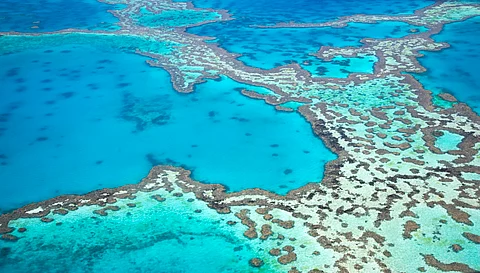

The Great Barrier Reef has suffered its sharpest coral loss in 39 years, with hard coral cover plunging over 70% in some areas.
The 2024 mass bleaching event, the fifth since 2016, coincided with record heat stress, cyclones and crown-of-thorns starfish outbreaks.
Scientists warn that frequent and intense bleaching events are leaving the reef with little time to recover, and the window to save it is rapidly closing.
The Great Barrier Reef has recorded its steepest decline in hard coral cover in almost four decades, as climate change-induced heat stress, cyclones and outbreaks of coral-eating starfish drive the ecosystem to the brink.
An annual survey by the Australian Institute of Marine Science (AIMS), released on 6 August 2025, confirmed that the 2024 mass coral bleaching event had the largest spatial footprint ever observed in the reef’s long-term monitoring programme spanning 39 years. In some areas, hard coral cover, the primary reef-building corals, fell by more than 70 per cent.
Scientists warned that the window to save the Great Barrier Reef (GBR) is rapidly closing, with the ecosystem facing increasingly frequent and severe bleaching events. The destruction of coral reefs was blamed primarily by the researchers on heat stress driven by climate change, compounded by cyclones, flooding and outbreaks of crown-of-thorns starfish, which are venomous predators that feed on corals.
The 2024 mass coral bleaching event was the fifth to strike the GBR since 2016 and forms part of the ongoing fourth global mass bleaching event, which began in 2023 in northern hemisphere reefs.
Between August 2024 and May 2025, AIMS surveyed 124 reefs across the northern, central and southern GBR under its Long-Term Monitoring Program (LTMP). Scientists found the lowest hard coral cover ever recorded since monitoring began in 1986.
According to the report:
48 per cent of surveyed reefs showed a decline in coral cover
42 per cent showed no net change
Only 10 per cent recorded an increase in cover
“In 2025, 48 per cent of surveyed reefs underwent a decline in percentage coral cover, 42 per cent showed no net change and only 10 per cent had an increase,” the report noted.
Aerial surveys in March 2025 showed that the northern and central regions, which endured the highest heat stress, were hardest hit. Of 162 inshore and mid-shelf reefs surveyed, 41 per cent recorded medium to high bleaching prevalence, with some areas reaching 60 per cent.
The northern GBR suffered the largest annual decline since 1986, with average hard coral cover shrinking from 39.8 per cent to 30 per cent, a 24.8 per cent drop compared with 2024 levels. Coral loss was greatest around Lizard Island, coinciding with the worst heat stress on record, along with cyclones and freshwater inundation, AIMS found.
In the central GBR, hard coral cover dropped 13.9 per cent to 28.6 per cent, while the lowest long-term average remains 19.8 per cent, recorded in 2009-2010. Stable or slightly increasing coral cover was mostly confined to this central zone.
The report found that reefs in the Cairns sector had lost between 6 per cent and 60 per cent of their coral cover, hit by severe bleaching and wave damage from tropical cyclone Jasper, a 2023 Australian region tropical cyclone, and the flood plume that followed.
The southern GBR saw the sharpest relative decline, with average hard coral cover falling from 38.9 per cent to 26.9 per cent in 2025 — a 30.6 per cent loss compared to 2024. This is the largest annual decline on record for the region, which previously saw a low of 29.3 per cent in 2009-2010.
Coral bleaching in the region was largely driven by the most extreme heat stress on record, particularly in the Capricorn-Bunker sector. Several reefs recorded their steepest drop in coral cover since monitoring began.
Scientists also found evidence of storm damage and high levels of coral disease, a common outcome in corals that survive bleaching events. Swains sector reefs continued to lose coral to crown-of-thorns starfish outbreaks.
Fast-growing, heat-resilient Acropora corals, which had fuelled a rapid recovery across many reefs between 2017 and 2024, were among the worst hit by 2024’s mass bleaching.
Mike Emslie, who leads the AIMS LTMP, in a press statement said the impact of substantial hard coral losses had been cushioned by record-high levels before the bleaching.
“We are now seeing increased volatility in the levels of hard coral cover. This is a phenomenon that emerged over the last 15 years and points to an ecosystem under stress. We have seen coral cover oscillate between record lows and record highs in a relatively short amount of time, where previously such fluctuations were moderate,” he said.
On the decline of Acropora, Emslie added: “We’ve said in the past that these corals are the fastest to grow and are the first to go, as they are susceptible to heat stress, cyclones and are a favourite food of crown-of-thorns starfish and this year’s results illustrate that.”
Mass bleaching events are becoming more intense and are occurring with more frequency, pointed out AIMS Chief Executive Selina Stead in the statement.
“This was the second time in a decade that GBR experienced mass bleaching in two consecutive years.”
Before the 1990s, such events were rare. The first major bleaching was recorded in 1998, followed by another in 2002. But since 2020, GBR has been hit in 2020, 2022, 2024 and now 2025. Scientists say the full impact of the latest event will not be known until fresh surveys next year. More frequent and intense heat stress make it challenging for corals to recover from bleaching events.
Globally, the picture is equally grim. The United States National Oceanic and Atmospheric Administration said that between January 2023 and May 2025, 83.9 per cent of the world’s coral reef area had been exposed to bleaching-level heat stress, up from 83.7 per cent in April, with mass bleaching reported in at least 83 countries and territories.